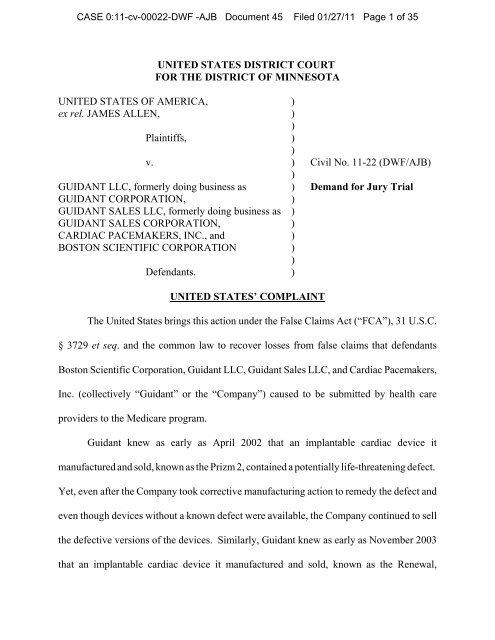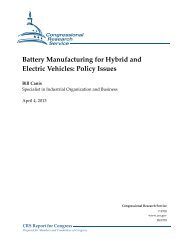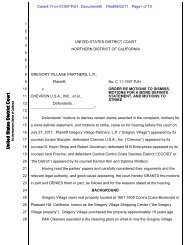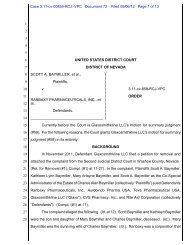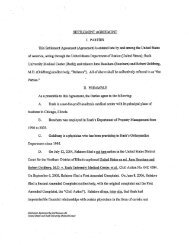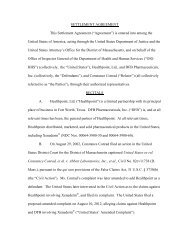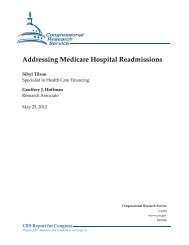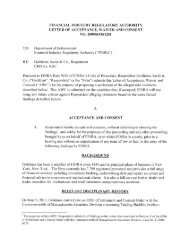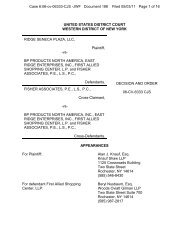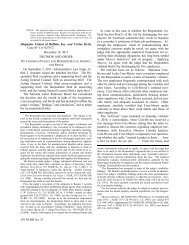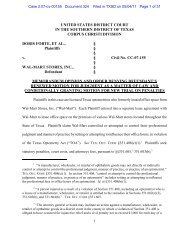K:\My Documents\Cases\Guidant\Court Filings\Complaint ... - BNA
K:\My Documents\Cases\Guidant\Court Filings\Complaint ... - BNA
K:\My Documents\Cases\Guidant\Court Filings\Complaint ... - BNA
Create successful ePaper yourself
Turn your PDF publications into a flip-book with our unique Google optimized e-Paper software.
CASE 0:11-cv-00022-DWF -AJB Document 45 Filed 01/27/11 Page 2 of 35contained a similar, potentially life-threatening defect. Yet, even after the Company tookcorrective manufacturing action to remedy the defect and even though devices without aknown defect were available, the Company continued to sell the defective versions of thedevices. Both times, Guidant failed to tell physicians, patients, the Food and DrugAdministration (“FDA”), and even its own sales force about the problems, and Guidanteventually pled guilty to misleading the FDA about its actions in connection with the Prizmand the Renewal.I. NATURE OF ACTION1. The United States brings this action to recover treble damages and civilpenalties under the FCA and to recover damages and other monetary relief under thecommon law theory of unjust enrichment.2. The United States bases its FCA claims on Guidant causing the submission offalse or fraudulent claims to the Medicare program in violation of 31 U.S.C. § 3729(a)(1).3. Generally, no payments may be made under Medicare for expenses incurredfor items and services that are not “reasonable and necessary” for the diagnosis and treatmentof an illness. 42 U.S.C. § 1395y(a)(1)(A).4. In 2002 and 2003, respectively, Guidant learned that two types of implantablecardiac devices that it manufactured and sold, the Ventak Prizm 2 DR and the ContakRenewal 1 and 2, had the potential to “arc,” which would lead the device to fail to deliver anecessary, and often potentially life-saving, shock to the patient with the implanted device.2
CASE 0:11-cv-00022-DWF -AJB Document 45 Filed 01/27/11 Page 5 of 35III.PARTIES18. The United States brings this action on behalf of the Department of Health andHuman Services (“HHS”) and the Centers for Medicare & Medicaid Services (“CMS”),which administers the Medicare program.19. James Allen is an individual residing in Lancaster, New York. He commencedan action on July 10, 2008 under the qui tam provisions of the FCA, which enable a privateperson to bring an action in the name of the government. Mr. Allen filed a First AmendedComplaint on July 22, 2010.20. Defendant Guidant Corporation was an Indiana corporation, with its principalplace of business at 11711 N. Meridian Street, Suite 850, Carmel, IN 46032. Guidant Corp.’sCardiac Rhythm Management (CRM) Division is the division that, upon information andbelief, at all times relevant to this Complaint, developed, researched, advertised, promoted,marketed, and sold all of Guidant’s implantable cardioverter defibrillators (“ICDs”),including the Prizm 2 and Renewal. Upon information and belief, at all times relevant to thisComplaint, the CRM Division’s operations were principally conducted out of its facilitiesat 4100 Hamline Ave. North, St. Paul, MN 55126.21. During the relevant time period, Guidant was organized as a corporation anddid business under the name “Guidant Corporation.” On or about February 19, 2010,Guidant Corp. filed articles of conversion with the Indiana Secretary of State to convert itscorporate form to a limited liability company, with the name “Guidant LLC.”22. Guidant LLC is a wholly-owned subsidiary of Boston Scientific Corporation.5
CASE 0:11-cv-00022-DWF -AJB Document 45 Filed 01/27/11 Page 6 of 3523. Guidant LLC was convicted of two misdemeanors in this District for violationsof the Food, Drug, and Cosmetic Act, 21 U.S.C. §§ 331(q)(2) and 331(q)(1)(B), for itsconduct relating to the Prizm 2 and the Renewal and to certain of the allegations herein.24. At all times relevant to this Complaint, Guidant Corp. (now Guidant LLC) soldthe Prizm 2 and Renewal devices through its wholly-owned subsidiary, defendant GuidantSales Corporation. On July 30, 2010, Guidant Sales Corporation filed articles of conversionwith the Indiana Secretary of State to become a limited liability company, with the new name“Guidant Sales LLC.” Guidant Sales LLC has its principal place of business at 4100Hamline Ave. North, St. Paul, MN 55112.25. Defendant Cardiac Pacemakers, Inc. is, upon information and belief, aMinnesota corporation with its principal place of business at 4100 Hamline Ave. North, St.Paul, MN 55112. Upon information and belief, Cardiac Pacemakers, Inc. is a wholly-ownedsubsidiary of Guidant Corporation (now Guidant LLC), and was so at all times relevant tothis action. Cardiac Pacemakers, Inc. was responsible for certain submissions to the FDAfor the devices at issue in this matter, including a submission that Guidant LLC has admittedwas false and misleading.26. Defendant Boston Scientific Corporation describes itself as a worldwidedeveloper, manufacturer, and marketer of medical devices. Boston Scientific is incorporatedin the State of Delaware, with its principal executive office located in Natick, Massachusetts.In 2006, Boston Scientific acquired Guidant Corporation (now Guidant LLC) and itssubsidiaries through a stock purchase agreement in which Guidant Corporation shareholders6
CASE 0:11-cv-00022-DWF -AJB Document 45 Filed 01/27/11 Page 7 of 35exchanged their shares for shares of Boston Scientific and cash. Guidant’s assets, liabilities,and operations have been relocated to other Boston Scientific entities, with Guidant LLCcontinuing to operate and to retain post-retirement benefit obligations, international tenderobligations, inter-company financial activities, and certain third-party contracts. Since thetransaction, Boston Scientific has operated as a successor of Guidant Corporation. Thesuccessor generation of products manufactured and sold by Guidant Corporation, includingthe devices at issue in this matter, are now manufactured and sold by Boston Scientific. Inaddition, the sales force previously employed by Guidant Corporation to sell ICDs is nowemployed by Boston Scientific in the same or similar capacity.IV.THE LAWA. The False Claims Act27. The FCA, 31 U.S.C. §§ 3729-33, provides for the award of treble damages andcivil penalties for, inter alia, knowingly causing the submission of false or fraudulent claimsfor payment to the United States Government. 31 U.S.C. § 3729(a)(1) (2006).28. The FCA provides, in pertinent part, that any person who:(a)(1) knowingly presents, or causes to be presented, to anofficer or employee of the United States Government or amember of the Armed Forces of the United States a false orfraudulent claim for payment or approval;* * *is liable to the United States Government for a civil penalty ofnot less than $5,000 and not more than $10,000, plus 3 times theamount of damages which the Government sustains because ofthe act of that person[.]* * *7
CASE 0:11-cv-00022-DWF -AJB Document 45 Filed 01/27/11 Page 10 of 35C. The Federal Medicare Program36. In 1965, Congress enacted Title XVIII of the Social Security Act, 42 U.S.C.§ 1395 et seq., known as the Medicare program. Entitlement to Medicare is based on age,disability, or affliction with end-stage renal disease. 42 U.S.C. §§ 426, 426A. Medicare isadministered by CMS, which is part of the Department of Health and Human Services. Atall times relevant to this Complaint, CMS contracted with private contractors referred to as“fiscal intermediaries” and “carriers” to act as agents in reviewing and paying claimssubmitted by health care providers. 42 U.S.C. § 1395h; 42 C.F.R. §§ 421.3, 421.100.37. For inpatient treatment, reimbursement to treating facilities (such as hospitals)is governed by Medicare Part A, 42 U.S.C. §§ 1395c-1395i-5. For outpatient treatment,reimbursement to health care providers (such as doctors) is governed by Medicare Part B,42 U.S.C. §§ 1395j-1395w-4.38. To obtain Medicare reimbursement, providers submit claims using forms(known as CMS 1500s for outpatient claims and UB-92 or UB-04 for inpatient treatment).Providers identify by code on the appropriate form, among other things, the principaldiagnosis of the patient and the procedures and services rendered.39. Under the Medicare program, “no payment may be made under part A or partB for any expenses incurred for items or services which . . . are not reasonable and necessaryfor the diagnosis or treatment of illness or injury or to improve the functioning of themalformed body member.” 42 U.S.C. § 1395y(a)(1)(A).10
CASE 0:11-cv-00022-DWF -AJB Document 45 Filed 01/27/11 Page 11 of 35V. IMPLANTABLE CARDIOVERTER DEFIBRILLATORS (“ICDs”)40. This case involves two lines of implantable cardiac devices manufactured byGuidant: the Ventak Prizm 2 DR (the “Prizm 2”) and the Contak Renewal 1 and 2 (the“Renewal”). Both products are defibrillators, which are designed to prevent sudden cardiacdeath by detecting and treating ventricular tachycardia and ventricular fibrillation. If thedevices detect tachycardia or fibrillation, they emit an electrical pulse to deliver a potentiallylife-saving “shock” to the heart to return it back to normal rhythm.41. More specifically, an ICD is an implantable medical device that is used tocorrect heart arrhythmia (abnormal heart rhythm). The device is surgically implanted in thepatient’s chest cavity and connected to the patient’s heart by electrical wires called “leads.”The “header” of the device is a formed plastic cap that channels wires from the device’smetallic pulse generator, which contains the battery, to a port where the wires are connectedto the leads. The “feedthrough wire,” located within the header, is designed to carry theelectrical charge from the pulse generator to the leads. Implantable cardiac resynchronizationtherapy defibrillators (“CRT-Ds”) are ICDs with an additional function that enables the heartto pump more efficiently.42. “Interrogation” describes the evaluation of an ICD and the retrieval of storedinformation from the device. An interrogation assesses various factors that could affect theperformance of the ICD, such as whether the leads or pulse generator are functioningnormally, the status of the battery, and whether an abnormal heart rhythm has been detectedby the ICD.11
CASE 0:11-cv-00022-DWF -AJB Document 45 Filed 01/27/11 Page 12 of 3543. Patients who are treated with ICDs include individuals with ventricularfibrillation (rapid, ineffective contraction of the ventricles of the heart), ventriculartachycardia (excessively rapid heartbeat), or significant thickening of the heart muscleresulting in arrhythmia. Such conditions can result in the loss of consciousness or death,unless the device delivers the proper therapy to put the patient’s heart back into a normalcardiac rhythm.44. Once implanted, a properly functioning ICD or CRT-D continuously monitorsthe patient’s heartbeat for irregular rhythms. If tachycardia is detected, the device willgenerate a series of timed, electrical pulses delivered to the heart along the leads to reset theheart to normal rhythm. Similarly, when ventricular fibrillation is detected, the device willdeliver sudden shocks along the leads to the heart to stop the potentially-fatal heart quivering.45. In 2002 and 2003, respectively, Guidant discovered that the Prizm 2 andRenewal devices suffered from an electrical defect known as “arcing.” Arcing occurs whenthe device detects the irregular heartbeat and delivers a shock, but instead of the currentgoing to the lead and then the heart, the current “arcs” back to the device itself. This causesthe device to divert energy away from the leads in a short circuit, rendering the deviceineffective to deliver therapy. A failure to deliver the potentially life-saving shock to thepatient can result in death.46. In August 2000, the FDA approved Guidant’s application for the Ventak Prizm2 DR Model 1861 (“Prizm 2”). In its notification to Guidant that the device had beenapproved, FDA reminded the Company of the requirement that “[b]efore making any change12
CASE 0:11-cv-00022-DWF -AJB Document 45 Filed 01/27/11 Page 13 of 35affecting the safety or effectiveness of the device, [Guidant must] submit a PMA supplementfor review and approval by FDA[.]” The FDA further specified to Guidant in the approvalfor the Prizm 2 that “[a] PMA supplement . . . be submitted when unanticipated adverseeffects, increases in the incidence of anticipated adverse effects, or device failures necessitatea labeling, manufacturing, or device modification.”47. Guidant first offered the Prizm 2 for sale in the United States in or about 2000.48. In 2002, the FDA approved Guidant’s application for the Contak Renewal 1Model H135 (“Renewal”). In its notification to Guidant that the device had been approved,FDA reminded the Company of the requirement that “[b]efore making any change affectingthe safety or effectiveness of the device, [Guidant must] submit a PMA supplement forreview and approval by FDA[.]” The FDA also required that “[a] PMA supplement . . . besubmitted when unanticipated adverse effects, increases in the incidence of anticipatedadverse effects, or device failures necessitate a labeling, manufacturing, or devicemodification.”49. Guidant first offered the Renewal for sale in the United States in or about 2002.VI. THE PRIZM 250. In or about February 2002, a physician observed that a Prizm 2 implanted inone of his patients had malfunctioned, leaving the doctor unable to interrogate the device.The device was subsequently surgically removed from the patient or “explanted,” andshipped to Guidant, which sent the device to its Reliability Lab for analysis.13
CASE 0:11-cv-00022-DWF -AJB Document 45 Filed 01/27/11 Page 14 of 3551. Guidant opened a tracking report, called a Field Discrepancy Notificationreport (“FDN”), in late February 2002. According to the FDN, Guidant’s lab technicianconcluded that a short between the feedthrough wire and the backfill tube (connected to thedevice case) inside the header was the cause of a high current condition, i.e., arcing. Thearcing depleted the battery, resulting in the inability of the physician to interrogate the deviceand rendering the device unable to deliver a shock if needed. The Guidant technician furthernoted that the insulation of the feedthrough tubing “appear[ed] to have a hole in it[.]”52. In March 2002, another physician reported to Guidant his observation of amalfunctioning implanted Prizm 2. The device was explanted and shipped to Guidant foranalysis.53. In the FDN for this second event, the Guidant lab technician noted that whenthe “[d]evice was charged up to approximately 570 volts, a loud spark and loud snap wasproduced from the header. Visual of the header found the DF negative wire is melted againstthe backfill tube.” The technician concluded that “corrective action is required . . . to ensurethe feedthru wire cannot short against the stem.”54. The arcing in Guidant’s Prizm 2 devices was caused by a breakdown in thepolyimide insulation in a feedthrough wire. When the wire, carrying a negatively chargedcurrent, was positioned too close to the positively charged backfill tube, the current wouldarc from the wire to the tube, causing the device to divert energy away from the leads in ashort circuit, rendering the device ineffective to deliver therapy.55. Guidant itself termed the arcing a “failure mode” for the device.14
CASE 0:11-cv-00022-DWF -AJB Document 45 Filed 01/27/11 Page 16 of 352002, corrective action the Company had implemented, nor did it describe the arcing failuremode.62. On or about November 13, 2002, Guidant implemented a second engineeringchange order for the Prizm 2 designed to address the arcing failure mode.63. Guidant regarded the November 2002 change order as, in the words of theformer CRM president, a “belt and suspenders” effort to address the arcing failure mode.64. Guidant did not submit a PMA supplement to the FDA before making theNovember 2002 change.65. The next Annual Report for the devices, submitted August 19, 2003, also didnot disclose the April 2002 manufacturing corrective action. Although it did refer to themanufacturing change the Company had undertaken in November 2002 to the Prizm 2,Guidant characterized that manufacturing corrective action as a “minor manufacturingchange[] [that did] not affect the safety or effectiveness of the device.” It further stated that“device performance is unaffected by this change . . . .” The report was submitted byGuidant Corp. and Cardiac Pacemakers, Inc.66. Guidant LLC has since acknowledged that the description of the manufacturingchanges in the 2003 Annual Report were false and misleading and has been convicted of aviolation of the FDCA, 21 U.S.C. §§ 331(q)(2) (prohibiting the submission of any requiredreport to the FDA that is false or misleading in any material respect) in relation to the 2003Annual Report.16
CASE 0:11-cv-00022-DWF -AJB Document 45 Filed 01/27/11 Page 17 of 35A. Guidant Continued To Sell Defective Devices That It Expected WouldFail67. After the implementation of the April 2002 Change Order, there were twodistinct Prizm 2 device populations being implanted by physicians into patients: (1) deviceswith the arcing defect that had been manufactured before the April 2002 Change Order and(2) devices manufactured after that manufacturing corrective action.68. Guidant expected that the defective device population would continue toexperience arcing events that would potentially put patients’ lives at risk. In contrast,Guidant did not anticipate any arcing events in the post-Change Order device population.69. On May 20, 2002, in order to track future arcing events internally, Guidantopened Trend Report TR 02019, titled “Feedthrough Wire to Backfill Tube Short.” Thetrend report distinguished between devices made before the corrective action and those madeafterwards. Guidant anticipated that the former population of devices likely would continueto experience arcing but the latter population would not.70. In a June 2002 Health Risk Assessment (“HRA”) that Guidant performed forthe Prizm 2 arcing defect, Guidant concluded that injury to a patient stemming from an arcingevent would be “life-threatening” because “unanticipated deaths could reasonably beexpected to occur[.]” (emphasis added). The HRA further concluded that there were nomitigation factors for this risk and that the risk affected the entire pre-fix Prizm 2 patientpopulation. Guidant did not disclose this assessment to physicians or to the FDA.17
CASE 0:11-cv-00022-DWF -AJB Document 45 Filed 01/27/11 Page 18 of 3571. In 2002 and early 2003, Guidant continued to receive reports from the fieldabout arcing in devices made prior to April 2002.72. Nonetheless, Guidant closed Trend Report TR 02019 in April 2003 becausethose failures were consistent with what the Company expected would happen—that somedevices manufactured before the corrective action would experience arcing and fail.73. In closing the Trend Report TR 02019, Guidant established criteria fordetermining when to reopen it: namely, the report of either four arcing events in a 12-monthperiod among the defective devices or a single arcing event from the fixed device population.74. In fact, more than the four arcing events did occur in the defective devicepopulation. A March 2004 Tachy Field Performance Monitoring Review states that no fewerthan eight arcing events were reported for the Prizm 2 in the preceding 12 months.75. Nonetheless, Guidant did not reopen TR 02019 because “[a]ll events were precorrectiveaction,” the failures did not occur in any devices made after the manufacturingchange, and the failures were consistent with what the company expected to happen in thedefective device population.76. After the Change Order was implemented in April 2002, there were still manydevices that had been manufactured before April 2002 on shelves as inventory in health carefacilities such as hospitals, or in stock held by Guidant sales representatives responsible fordistributing and selling the devices.77. Guidant continued to sell its existing stock of defective devices after theimplementation of the April 2002 Change Order.18
CASE 0:11-cv-00022-DWF -AJB Document 45 Filed 01/27/11 Page 19 of 3578. Instead of alerting physicians, patients, or even its own sales force about thearcing issue, asking for the return of devices made before April 2002 or issuing a recall,Guidant did nothing.79. As a result, nearly 4,000 devices manufactured before April 2002 that had thearcing defect and the attendant potential to fail to deliver a life-sustaining shock wereimplanted by physicians into patients in the United States after April 2002, when neither thephysicians nor the patients knew about the defect or the risks. Approximately 1,800 of theseimplants were in Medicare patients.80. The implantation of Prizm 2 devices with the arcing defect when non-defectivedevices were available was “not reasonable and necessary for the diagnosis or treatment ofillness or injury or to improve the functioning of the malformed body member.” 42 U.S.C.§ 1395y(a)(1)(A).81. From 2002 until 2005, the Company learned of at least 26 separate arcingevents that had occurred in patients that had Prizm 2 devices that had been manufacturedprior to the corrective action.82. One of these failure events occurred in March 2005 in the defective deviceimplanted in a 21-year-old patient, J.O., who died of cardiac arrest after his Prizm 2 failedto deliver the shock he needed to return his heart rhythm to normal and to save his life.83. In total, out of about 27,000 pre-fix Prizms sold that had the potential to arc,there are at least 39 confirmed arcing events and four patient deaths potentially attributable19
CASE 0:11-cv-00022-DWF -AJB Document 45 Filed 01/27/11 Page 20 of 35to Prizm arcing. In bench testing of explanted devices, Guidant observed that at least 19additional Prizm 2 devices experienced arcing that rendered the devices inoperable.B. The Renewal Devices84. Between November 2003 and July 2004, Guidant learned of four separatearcing events that took place in Renewal devices implanted in patients. One such eventresulted in the failure of a device to deliver potentially life-saving therapy to a patient whodied after suffering a cardiac arrest.85. The first reported arcing event occurred on November 18, 2003, after aphysician observed that his patient’s device presented low shocking impedance (i.e. current)on the leads upon interrogation. The device was explanted on November 19, 2003, andreturned to Guidant for analysis.86. The second arcing event occurred on May 7, 2004.87. On or about July 28, 2004, Guidant implemented a manufacturing correctiveaction to address the propensity of the Renewal to arc. As with the Prizm 2, the designchange, accomplished through ECO 53528, called for extra medical adhesive to be addedbetween the pulse generator and the wires to provide additional insulation at the site wherethe arcing had been observed.88. At that time, Guidant did not disclose the manufacturing corrective action ofthe Renewal to the FDA.20
CASE 0:11-cv-00022-DWF -AJB Document 45 Filed 01/27/11 Page 21 of 3589. Through the summer of 2004, Guidant anticipated that more failures wouldoccur within the defective device population and the Company continued to monitor anddiscuss the arcing problem in the Renewal.90. On or about August 25, 2004, the Renewal arcing issue was presented toGuidant’s Product Performance Committee (“PPC”), a committee responsible for“prioritizing, approving, and monitoring corrective actions for product performance[.]” Laterthat day, the PPC presented the issue to Guidant’s Product Evaluation Committee (“PEC”).The PEC is a committee charged with “provid[ing] an independent review of significantpatient health and safety issues (realized or potential) associated with [a] fielded product.”91. That same day, August 25, 2004, the PEC recommended that the Company stopshipment of all Renewals. The recommendation was based on “the severity of the [Renewalarcing] issue.”92. The PEC did not at that time recommend that the company communicate withphysicians or sales representatives in order to retrieve devices or stop implants of devices thathad already been sent to the field or sold to customers.93. The following day, August 26, 2004, based on the PEC recommendation,Guidant implemented “stop ship” and “stop build” orders to cease the manufacture andshipment of Renewals from Guidant’s factory. The orders did not apply to Renewals thathad previously shipped out from the factory and that Guidant sales representatives still hadin their possession.21
CASE 0:11-cv-00022-DWF -AJB Document 45 Filed 01/27/11 Page 22 of 3594. During a September 7, 2004, meeting of the PPC, committee membersdiscussed a 1992 article concerning a study that concluded that polyimide—the material thatGuidant had used to insulate the wires in the Renewal and Prizm 2—tends to deteriorate inmoist and warm conditions. The article had been identified several days earlier by a Guidantlaboratory engineer.95. By mid-September, the Company concluded that the polyimide insulation was,indeed, the root cause of the arcing problem it was seeing in the Renewal.96. On September 28, 2004, the PPC met again and recommended that theCompany continue to sell field inventory, including trunk stock (i.e., defective devicesmanufactured before the “stop ship” order that had been previously distributed to salesrepresentatives for sale).97. This recommendation was elevated to Guidant’s Officer Escalation Group(“OEG”). The OEG was a committee consisting of senior staff, including vice presidents andthe general counsel, and was responsible for reviewing items elevated to it from the PPC, inparticular, “[i]ssues that may require a Safety Alert or broad physician communication dueto a customer satisfaction issue.”98. The OEG approved the PPC’s recommendation to continue to sell fieldinventory.99. In the following months, as the Company expected, Guidant continued toreceive reports of arcing events occurring in Renewals that had been made before themanufacturing corrective action.22
CASE 0:11-cv-00022-DWF -AJB Document 45 Filed 01/27/11 Page 23 of 35100. In September 2004, Guidant conducted an internal test of Prizm I devices,which also contained polyimide. Of the ten Prizm I devices Guidant tested, all ten of themexhibited “cracking” in the device’s polyimide tubing. A similar test of Renewal devicesshowed that at least two out of the five devices experienced “cracking” in the polyimideinsulation, and a third device was found to be “questionable.”101. On November 19, 2004, Guidant submitted a “Real Time Review Request” tothe FDA for a redesigned header, in which it told the agency that the design change was a“manufacturing change to improve process throughput” and specifically said that the changewas “not being done to correct device flaws that threaten patient safety.” In fact, however,Guidant made the change in order to correct the arcing problem. Moreover, the Real TimeReview request did not mention the now-known cause of the arcing, the projected rate offailure, or that Guidant had ordered the factory to stop building and shipping the devices.102. Guidant learned of a tenth confirmed Renewal arcing event in January 2005.103. At a January 5, 2005, special meeting of the PPC, the committee tasked RenRussie, Director of Product Performance Reporting and Quality Assurance, and Dan Tich,Manager of Product Performance Communications, with evaluating possible physiciancommunications concerning the arcing defect in the Renewal and presenting arecommendation as to which communication the company should issue.104. In an email to the members of the PPC dated January 5, 2005, Russie identifiedsix “[c]ommunication [p]ossibilities” for the Company to consider, including recalling the23
CASE 0:11-cv-00022-DWF -AJB Document 45 Filed 01/27/11 Page 24 of 35device. In the email, Russie recommended either a product update or a safety advisory, bothof which would include “specific background” about the Renewal.105. The next day, Russie distributed a draft physician communication to the PPCcommittee. The draft described the arcing defect and anticipated that by the time thecommunication was sent, Guidant would already have “removed all non-implantedRENEWAL and RENEWAL 2 CRT-Ds from hospital shelves and Guidant inventory.”106. Minutes from a January 7, 2005, meeting of the PPC state that the committee,among other things: (1) “agreed to recommend to OEG that communication [to physicians]was appropriate” and (2) “agreed to recommend to OEG that remaining shelf devices shouldbe pulled.” Following the meeting, a “Dear Doctor” letter was drafted that laid out whatGuidant understood about the arcing problem and how it presented. Additionally, apresentation for the FDA was drafted that, had it been submitted to the FDA, would havedisclosed the arcing problem and acknowledged that “unanticipated deaths could reasonablybe expected to occur.”107. Rather than taking clear, robust action to alert the FDA, physicians, andpatients about the arcing issue and to prevent future implants of the defective devices,Guidant instead developed a plan designed to attract the least amount of attention possible.108. On the afternoon of January 7, 2005, Dr. Joseph Smith, a CRM Chief MedicalOfficer, suggested that, rather than the approach in the draft communication from Russie, thephysician communication focus instead on the “yellow screen.” This refers to a yellowcomputer screen that was designed to appear as a physician interrogated an implanted device24
CASE 0:11-cv-00022-DWF -AJB Document 45 Filed 01/27/11 Page 25 of 35at a routine patient visit and a problem was detected in the leads of the device. The warningsaid that “A LOW shocking lead impedance has been recorded. Please evaluate leadintegrity.” The warning did not refer to any potential malfunction with the pulse generator,the ICD itself, or to arcing in particular, although by that time Guidant knew that this yellowscreen mentioning only the leads was what appeared if the device had arced.109. In an email sent that same day, Russie expressed reservations with theapproach that Smith had proposed. Russie stated that “[t]his would lead to virtually zeroexplants.” He noted the approach “falls short” in that it “[d]oesn’t provide a mechanism toremove product from the field” and “will seem wholly inadequate in the future if the failurerate becomes high.”110. In a January 10, 2005, meeting, the OEG considered a PPC recommendationthat Guidant “[r]emove (recall) remaining pre-corrective action product from distributionbecause it now appears to perform worse than Prizm 1[.]” On information and belief, theOEG rejected the PPC’s recommendation.111. The PPC met again later that day. One Guidant employee memorialized thediscussion at the meeting in his notebook: “Can we go get devices? . . . . Would prefergeneric letter. . . . . Can we do this quietly without focusing on R1/R2 [Renewal 1 and 2]?”(emphasis added). The PPC eventually settled on a method of “quietly” retrieving thedevices. At the PPC meeting on January 10 th or 11 th , “Chris Harrold [the Director ofCompliance] reported that it would be possible to pull shelf devices for testing without aformal recall.”25
CASE 0:11-cv-00022-DWF -AJB Document 45 Filed 01/27/11 Page 26 of 35112. Thus, instead of recommending a recall, which would require notification tothe FDA, the PPC changed course and “agreed to recommend to OEG that remaining shelfdevices should be pulled for testing.” The committee “asked the technical team to developtests to support a recommendation of changed device settings[.]”113. Had Guidant initiated a formal recall, it would have been required to notify theFDA, and a recall also would have led to communication with the public and health careproviders who purchased the devices about the arcing defect. 21 C.F.R. §§ 7.42, 7.46, 7.49,7.50.114. The PEC concurred in the PPC’s recommendation the next day, January 11,2005, and agreed to recommend the plan to remove the devices “for testing” to the OEG.The OEG was briefed on this plan on January 13, 2005.115. On January 12, 2005, Tich sent an email to other members of the PPC,attaching yet another version of a draft physician communication concerning the Renewal.Tich asked his fellow committee members to consider whether the Company should issue a“Product Update,” as opposed to a “Safety Alert,” because a “Product Update approachwould raise less suspicion regarding our motivations, as it appears to be more ‘business asusual.’ If things get worse and we have to divulge more information, it will not appear inretrospect, as if we were hiding anything.”116. Guidant chose the “business as usual” Product Update approach, issuing sucha communication in March 2005. The Update did not mention arcing, the degradation of thepolyimide insulation, or the possibility of deaths resulting from the known defect.26
CASE 0:11-cv-00022-DWF -AJB Document 45 Filed 01/27/11 Page 27 of 35117. To the contrary, in the “Q&A” section—which accompanied the ProductUpdate and was sent only to Guidant sales representatives to assist in their communicationswith physicians—the Update stated that the reason for the communication was a “handfulof calls” the Company had received concerning “the appropriate steps to take when a yellowshorted shock lead warning screen appears.”118. The Company emphasized in the Q&A that the Product Update was not arecall or safety alert, but rather a “normal Product Update” and that “Guidant ReliabilityAssurance publishes Product Updates regularly to ensure that physicians are fully educatedon the latest information with regard to the management of our devices.” The Q&Aexpressly represented that “nothing was ‘broken.’”C. The Arcing Defect Is Made Public119. In March 2005, J.O. died of cardiac arrest after his defective Prizm 2 failed todeliver a potentially life-saving shock due to arcing. J.O.’s physician, Dr. Robert Hauser,learned of the defect in the Prizm 2 when he contacted the Company about his concernregarding the failure of the device to deliver necessary therapy to J.O. On or about May 12,2005, Dr. Hauser sent an email to various physicians notifying them about J.O.’s death andthe defect in the Prizm.120. Guidant then created a “Prizm 2 Action Plan,” in which it decided that it wouldnot communicate about the defect to its sales representatives so long as only a limited amountof people outside Guidant knew of the problem. Specifically, in a meeting on May 14, 2005,Guidant decided that it would not initiate a field communication unless:27
CASE 0:11-cv-00022-DWF -AJB Document 45 Filed 01/27/11 Page 28 of 351) We see a dramatic influx of calls relating to this issue2) We determine that Medtronic/St. Jude has obtained a photocopy of the Dr.Hauser email3) We determine that knowledge of this incident has escaped outside of thephysicians notified by the Hauser email4) We receive inquiries on this from the FDA121. On or about May 19, 2005, the New York Times contacted Guidant, informingthe Company of its intent to run an article concerning the Prizm defect and the death of J.O.122. Shortly after learning of the Times’ intent to publish the article, Guidantcontacted the FDA to discuss the possibility of a “Dear Doctor” letter addressing the arcingdefect.123. On May 23, 2005, Guidant issued its first “Dear Doctor” letter informingphysicians of the arcing defect in the Prizm devices. It did not mention the cause of thearcing, or that it potentially presented in every device, and said it was a “rare andunpredictable . . . random component failure,” even though Guidant knew the cause,mechanism, and predicted rate of failure. The letter made no mention that the Renewaldevices also suffered from the arcing defect. In fact, Guidant explicitly stated in a Q&A toits sales representatives accompanying the letter that “[a]ll other Guidant products . . . are notsusceptible to this failure mode.”124. On May 24, 2005, the New York Times ran a front-page story about J.O.’s deathand how Guidant had hidden the defects in the Prizm for years. According to the article,J.O.’s physicians learned that Guidant had been aware of the arcing risk. His physicians28
CASE 0:11-cv-00022-DWF -AJB Document 45 Filed 01/27/11 Page 29 of 35(Drs. Hauser and Barry Maron) also stated that they would have explanted his device hadthey known about the arcing defect.125. On June 17, 2005, Guidant issued two “Dear Doctor” letters titled, “URGENTMEDICAL DEVICE SAFETY INFORMATION & CORRECTIVE ACTION.” The lettersfinally disclosed the full extent of the arcing problem with both the Prizm 2 and the Renewal1 and 2 to physicians.126. The June 2005 “Dear Doctor” letters stated that the arcing malfunction in thesedevices “causes damage to the device circuitry, potentially resulting in the inability to deliverthe required shock during episodes of arrhythmia.” The letters further stated that the“malfunction could lead to a serious, life-threatening event” and that the devices did notprovide any warning that they would fail. The Company further acknowledged that it wasnot possible to estimate the number of devices that might experience such a failure.127. By the date of the June 2005 Dear Doctor letters, few, if any, defective Prizmsand Renewals remained on hospital shelves or in trunk stock because they had already beenimplanted by physicians in unsuspecting patients or returned to the company.128. Overall, out of about 16,000 pre-fix Renewals sold that had the potential to arc,there are at least 83 confirmed Renewal arcing events and nine confirmed patient deathspotentially attributable to the Renewal arcing defect.129. Over 200 devices manufactured before July 28, 2004, the date when Guidantimplemented the manufacturing corrective action addressing the known arcing defect in theRenewal, and that had the arcing defect and the attendant potential to fail to deliver a life-29
CASE 0:11-cv-00022-DWF -AJB Document 45 Filed 01/27/11 Page 30 of 35sustaining shock, were implanted by physicians into patients in the United States after July28, 2004. Approximately 150 of the implants were in Medicare patients.130. The implantation of Renewal devices with the arcing defect when nondefectivedevices were available was “not reasonable and necessary for the diagnosis ortreatment of illness or injury or to improve the functioning of the malformed body member.”42 U.S.C. § 1395y(a)(1)(A).131. The FDA classified the June 17 letters as Class I recalls for those devices.132. Class I recalls are the most serious type of recall and involve situations inwhich there is a reasonable probability that use of the product will cause serious adversehealth consequences or death. 21 C.F.R. § 7.3(m)(1).133. The FDA ultimately determined that the Prizm 2 devices that had beenmanufactured before the April 2002 manufacturing corrective action and the Renewaldevices that had been manufactured before the August 26, 2004, stop shipment date wereadulterated.134. Guidant LLC has been convicted of two misdemeanors relating to the arcinginvestigation. Count One, relating to the Prizm, is under section 331(q)(2) (prohibition onthe submission of a report to the FDA that is false or misleading in any material respect) andrelates to the August 2003 report that stated that the design change did not affect the safetyof the device. Count Two, relating to the Renewal, is under section 331(q)(1)(B) (failure tofurnish any notification or other material required under the FDCA) and relates to the March2005 Product Update, which was a correction that was not properly reported to the FDA.30
CASE 0:11-cv-00022-DWF -AJB Document 45 Filed 01/27/11 Page 31 of 35VII.FALSE CLAIMS135. As a result of its fraudulent course of conduct, Guidant knowingly caused thesubmission of false or fraudulent claims for implants of faulty Prizm 2 and Renewal devicesto the Medicare program. These false or fraudulent claims were not eligible for paymentbecause the services were not “reasonable and necessary for the diagnosis or treatment ofillness or injury . . . .” 42 U.S.C. § 1395y(a)(1)(A).136. A list of claims submitted to Medicare relating to the implant of the faultyPrizm 2 and Renewal devices at issue in this matter has been compiled in an electronic dataformat that will be served on Guidant contemporaneously with the United States’ ComplaintIn Intervention. The detailed claims information includes (a) the facility at which the implanttook place; (b) the patient’s name and Medicare ID number; (c) the type of device and datethe device was manufactured; (d) the date of the implant; and (e) the amount paid for theservices relating to the implant of the device that was paid by Medicare. The claims data hasnot been filed on the public record in order to protect confidential patient informationcontained therein.137. By way of example, listed below are ten example false claims to Medicare forthe implantation of the Prizm and Renewal devices into patients, including six false claimsfor Prizm devices implanted in this District.31
CASE 0:11-cv-00022-DWF -AJB Document 45 Filed 01/27/11 Page 32 of 35Patient Facility Date ofServiceDevice MedicareReimbursementAFairview Southdale Hospital(MN)April 24, 2002 Prizm $ 30,171.36BFlorida Hospital Medical Center(FL)April 25, 2002 Prizm $ 35,763.43CCharleston Area Medical Center(WV)May 20, 2002 Prizm $ 35,811.00DAbbott Northwestern Hospital(MN)May 22, 2002 Prizm $ 20,201.14E Methodist Dallas (TX) June 5, 2002 Prizm $ 35,756.22FAbbott Northwestern Hospital(MN)June 5, 2002 Prizm $ 27,048.42G United Hospital (MN) June 7, 2002 Prizm $ 24,767.64H United Hospital (MN) June 25, 2002 Prizm $ 32,631.53IAbbott Northwestern Hospital(MN)August 21, 2002 Prizm $ 24,594.98JWestern Pennsylvania Hospital(PA)July 30, 2004 Renewal $ 44,611.5K Providence Hospital (AL) August 17, 2004 Renewal $ 25,342.47LWinchester Medical Center October 14,(VA)2004Renewal $ 46,130.2032
CASE 0:11-cv-00022-DWF -AJB Document 45 Filed 01/27/11 Page 33 of 35forth herein.FIRST CAUSE OF ACTION(False Claims Act: Presentation of False Claims)(31 U.S.C. § 3729(a)(1))138. The United States repeats and realleges the preceding paragraphs as if fully set139. Guidant knowingly caused to be presented false or fraudulent claims forpayment or approval to the United States for the implantation of defective Prizm 2 andRenewal devices that were not reasonable and necessary and therefore were not reimbursableby the Medicare program.140. By virtue of the false or fraudulent claims that Guidant caused to be made, theUnited States suffered damages and therefore is entitled to treble damages under the FalseClaims Act, to be determined at trial, plus civil penalties of not less than $5,500 and up to$11,000 for each violation.forth herein.SECOND CAUSE OF ACTION(Unjust Enrichment)141. The United States repeats and realleges the preceding paragraphs as if fully set142. As a consequence of the acts set forth above, Guidant was unjustly enrichedat the expense of the United States in an amount to be determined which, under thecircumstances, in equity and good conscience, should be returned to the United States. TheUnited States claims the recovery of all monies by which Guidant has been unjustly enriched.33
CASE 0:11-cv-00022-DWF -AJB Document 45 Filed 01/27/11 Page 34 of 35PRAYER FOR RELIEFWHEREFORE, the United States demands and prays that judgment be entered in itsfavor against Guidant as follows:1. On the First Count under the False Claims Act, for the amount of the UnitedStates’ damages, trebled as required by law, and such civil penalties as are required by law,together with all such further relief as may be just and proper.2. On the Second Count for unjust enrichment, for the damages sustained and/oramounts by which Guidant was unjustly enriched or by which Guidant retained illegallyobtained monies, plus interest, costs, and expenses, and for all such further relief as may bejust and proper.DEMAND FOR JURY TRIALThe United States demands a jury trial in this case.34
CASE 0:11-cv-00022-DWF -AJB Document 45 Filed 01/27/11 Page 35 of 35Respectfully submitted,TONY WESTASSISTANT ATTORNEY GENERALJOHN R. MARTIATTORNEY FOR THE UNITED STATESActing under authority conferredby 28 U.S.C. § 515Dated: January 27, 2011 s/ D. Gerald WilhelmBY: D. GERALD WILHELMAttorney ID Number 117122CHAD A. BLUMENFIELDAttorney ID Number 387296Assistant United States Attorneys600 U.S. Courthouse300 South Fourth St.Minneapolis, MN 55415Gerald.Wilhelm@usdoj.govChad.Blumenfield@usdoj.govTel.: (612) 664-5600s/ Jonathan H. GoldJOYCE R. BRANDAJAMIE ANN YAVELBERGJEFFREY S. GLEASONJONATHAN H. GOLDAttorneys, Civil DivisionUnited States Department of JusticeP.O. Box 261, Ben Franklin StationWashington, D.C. 20044Jonathan.Gold@usdoj.govTel.: (202) 353-712335


